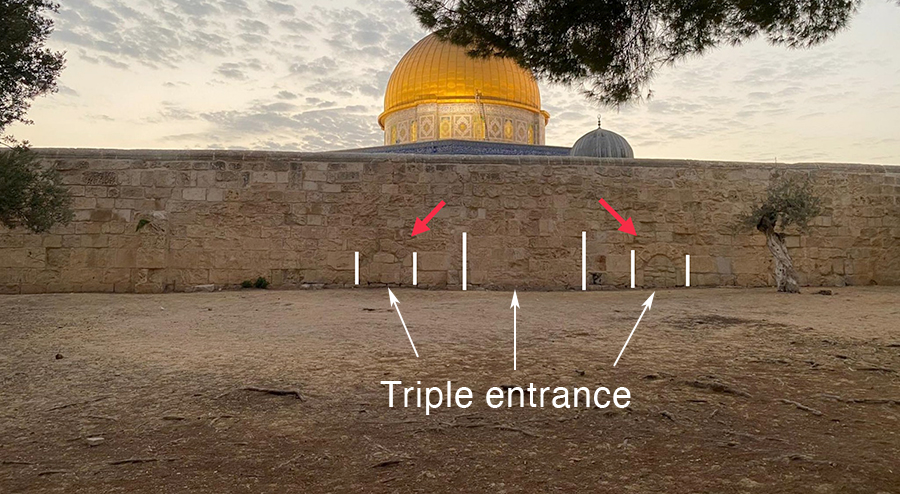Here is my translation of an article written on the 4th of October 2020 by Arnon Segal for the Makor Rishon Hebrew newspaper with additional comments and illustrations.
“In the eastern wall of the Raised Platform on which the Nikanor Gate stood during the days of the Temple, two arches were recently discovered that had been blocked at some point. Where did they lead to and who built them? And does this have anything to do with the holiday of Sukkot?”
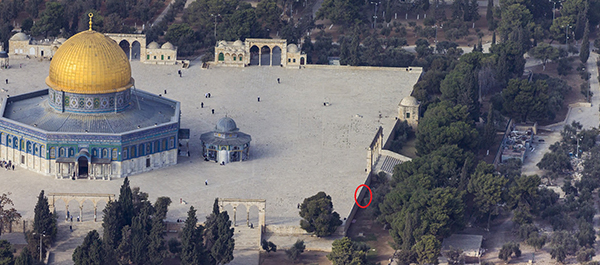
“The eastern wall of the Raised Platform that supports the plaza around the Dome of the Rock, is closely connected with Sukkot (the Feast of Tabernacles, or Booths). According to the Jewish tradition that places the Holy of Holies in the center of the Dome of the Rock, the Nicanor Gate stood on this wall during the days of the Temple. The staircase that descends from it today numbers 25 steps, but originally there were only 15 steps. On the feast of Beit Hashoeva (the Water Drawing ceremony) on the feast of Sukkot, when they went down to draw water from the Pool of Siloam, the Levites stood on these steps and sang the 15 songs of the degrees in the Book of Psalms.”
“This wall is oriented in an almost precise north-south line (a half-degree deviation that may be explained by a certain change in the magnetic north for thousands of years), just as the Temple itself was oriented according to precise astronomical directions. This eastern wall preserves a memory of the most significant difference in height on the ancient Temple Mount, namely that which separated the higher Court of Israel from the lower Court of the Women.”
“In recent weeks, Dr. Eli David has noticed two blocked arches on this wall, which as far as is known, are not mentioned in the research literature of the Temple Mount from the 19th century. There seemed to be a passage here that had been blocked at some time in the past. Archaeologist Dr. Leen Ritmeyer, who has been researching the Temple Mount since the 1970s, also did not know these arches, but has now speculated that they were built during the Crusader period or even earlier.”
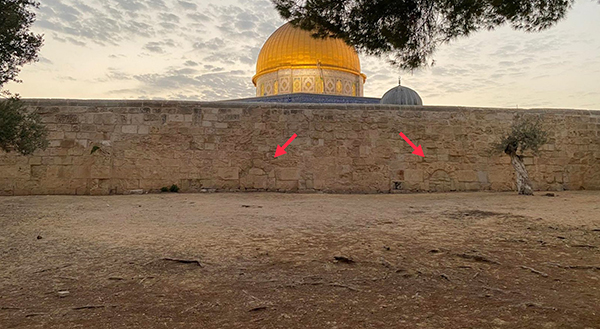
“According to Ritmeyer, the plaza round the Dome of the Rock was probably founded in the seventh or eighth century AD for the purpose of supporting the Dome of the Rock. And yet, it probably also incorporates much older components. At the northern end of this wall there are three courses of ancient construction that also extend along the northern wall of the Raised Platform. In his hypothesis it is possible that this corner served as an end to the soreg which marked the area beyond which foreigners and the unclean were forbidden to enter.”
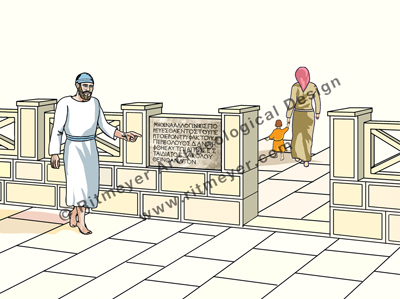
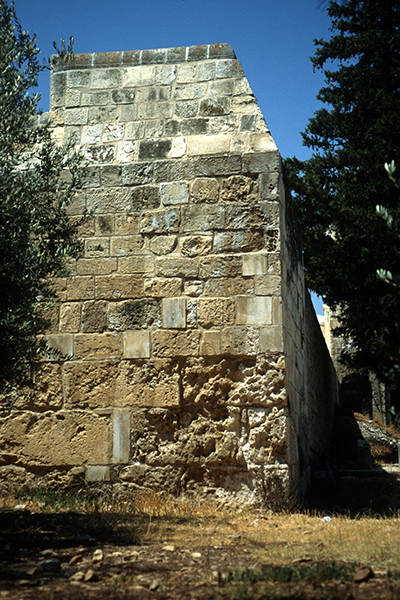
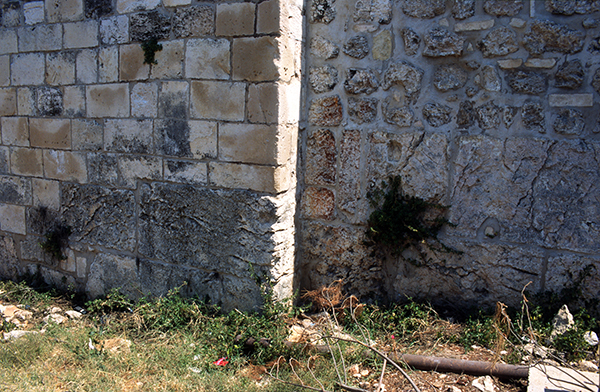
“At the southern end of the eastern wall, there are indications of the existence of additional underground spaces that have been sealed off. In the mid-19th century, the British expedition officer Charles Warren asked permission to explore this space, but the very next day a pile of earth was placed in front of the opening that prevented it, a pile that was later replaced by a stone blocking wall. According to Ritmeyer’s calculations, this was the place of the Chamber of Hewn Stone where the Sanhedrin used to hold court sessions.”
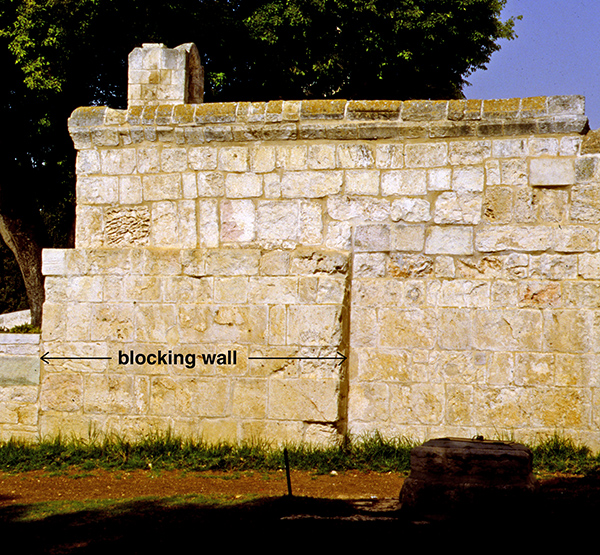
“And this wall has a few more things to tell us. At one point in the wall, north of the stairway, two large stones remain at the base of the wall, which Ritmeyer speculates may have been from the time of Herod and may have served as part of the retaining wall of the Court of the Women.”
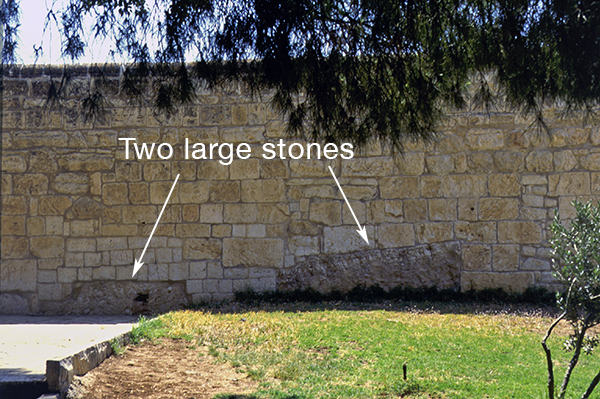
“Going back to the blocked arch openings located by Dr. Eli David, Ritmeyer points out that on the sides of these two arches two large stones can be seen that seem to belong to a triple opening. According to Ritmeyer, it is difficult to date the exact style of construction, but in his opinion, these are stones are similar to the ancient stone courses mentioned before, which are located at the northeast corner of the eastern wall. In his estimation, the opening may be from the Crusader period or even earlier. “These architectural remains show that there is still much to explore and discover,” Ritmeyer admits, “not only around the outer walls of the Herodian Temple Mount, but also on the Temple Mount plaza itself.”
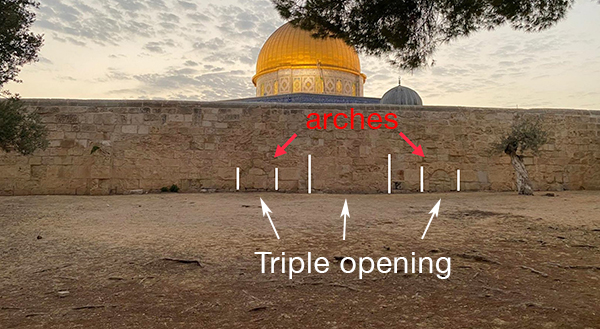
“Even if Dr. Ritmeyer assumes that the arches are from the Crusader period, they may have served as an opening to a much earlier underground space. When was it created and by whom?”
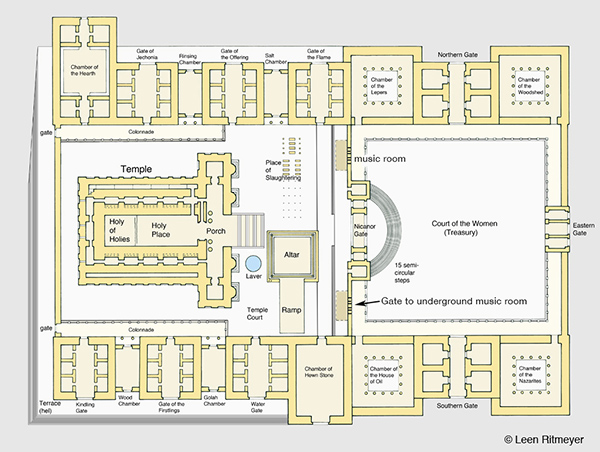
The Sanctuary itself consisted of three courts, each higher than the former, and beyond them, the Temple with the Holy and Most Holy Places. One could enter via the Eastern Gate, first into the Court of the Women or Treasury. A southern and a northern gate also led into the Court of the Women.
From the Court of the Women, men could advance up the 15 semi-circular steps and through the Nicanor Gate into the Court of Israel and then into the Court of the Priests. The underground Music Rooms were located at either side of the Nicanor Gate. Three gate buildings were located on both the north and south side of the Temple. The Chamber of the Hearth was in the northwest corner of the temple Court and the Chamber of Hewn Stone in the southeast. © Leen Ritmeyer
“It is not clear, but perhaps one should recall the words of Tractate Middot (2:6) regarding this very place, which indicates that this is the place where the musical instruments of the Temple were stored:
“And there were chambers under the Court of Israel, which opened to the Court of the Women, where the Levites played upon harps and lyres and the cymbals and all instruments of music”. At the Simchat Beit Hashoeva (the rejoicing of the Water Ceremony) that took place on the holiday nights, they played loudly.”
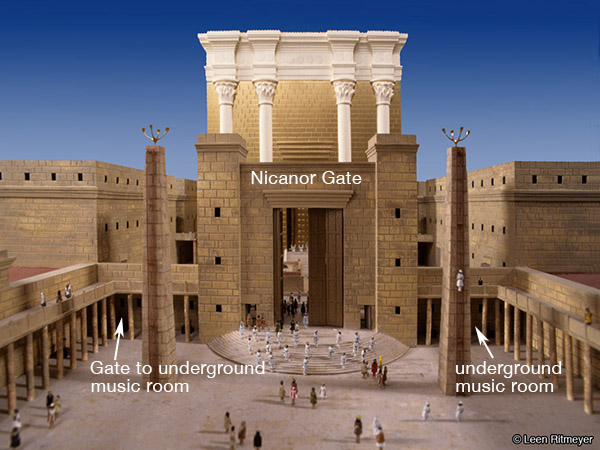
I find it very exciting to speculate that some remains of the entrance to this Music Room may have survived the Roman destruction of 70 AD. It is of special importance that this discovery was made during the days of Sukkot.
Music played an important role during the Feasts of Israel, especially during the present days of Sukkot. Trumpets were used to announce Rosh Hashanah, the beginning of the civil New Year, which fell on the 19th of August 2020. On the 10th of Tishrei, which was the 29th of September, was Yom Kippur, the Day of Atonement. During a Jubilee year, the trumpet of the Jubilee was sounded on the tenth day of the seventh month; on the Day of Atonement you shall make the trumpet to sound throughout all your land. And you shall consecrate the fiftieth year, and proclaim liberty throughout all the land to all its inhabitants. It shall be a Jubilee for you; and each of you shall return to his possession, and each of you shall return to his family (Leviticus 25:9,10).
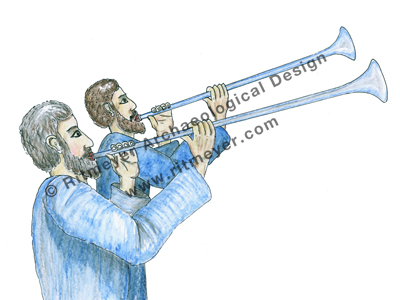
Every morning of Sukkot at daybreak, a group of Levites and priests went down to the Siloam Pool, which is located south of the Temple Mount, and drew three log (a Talmudic liquid measurement) of fresh water to be poured on the altar after the daily morning sacrifice. Their arrival at the Temple with the water was accompanied by trumpet blasts. (For Shabbat, the water was collected before the onset of Shabbat and stored in a golden vessel in the Temple.) It says in the Talmud: He who has not seen the Water-Drawing Celebration has never seen joy in his life.
Jesus used this act to draw the attention of the spectators to this ceremony when he said in John 7.37–39: “If any man thirst, let him come unto me, and drink. He that believeth on me, as the scripture hath said, out of his belly shall flow rivers of living water.”

